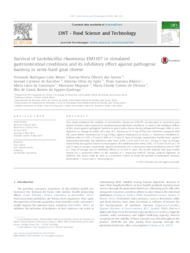Survival of Lactobacillus rhamnosus EM1107 in simulated gastrointestinal conditions and its inhibitory effect against pathogenic bacteria in semi-hard goat cheese.
Survival of Lactobacillus rhamnosus EM1107 in simulated gastrointestinal conditions and its inhibitory effect against pathogenic bacteria in semi-hard goat cheese.
Author(s): ROLIM, F. R. L.; SANTOS, K. M. O. dos; BARCELOS, S. C. de; EGITO, A. S. do; RIBEIRO, T. S.; CONCEIÇÃO, M. L. da; MAGNANI, M.; OLIVEIRA, M. E. G. de; QUEIROGA, R. de C. R. do E.
Summary: Abstract: This study evaluated the viability of Lactobacillus rhamnosus EM1107 incorporated in semi-hard goat cheese (Coalho) when exposed to simulated gastrointestinal conditions, as well as the inhibitory effects of this strain against pathogenic bacteria in goat Coalho cheese during refrigerated storage. After in vitro digestion, no change in viable cell count of L. rhamnosus (6.75 log CFU/g) was observed compared with the count before simulation (6.53 log CFU/g). Against Staphylococcus aureus, L. rhamnosus exhibited inhibition rates of 1.55%, 1.7% and 21.66% at 7, 14 and 21 days of storage, respectively. Furthermore, against Salmonella Enteritidis, the inhibition rates were 4.36%, 5.33% and 5.51% at 7, 14 and 21 days of storage, respectively and against Listeria monocytogenes, the inhibition rates were 2.62%, 1.57% and 10.23% at 7, 14 and 21 days of storage, respectively. Against Escherichia coli, L. rhamnosus showed inhibition rate of 7.98% at 7 days of storage and no inhibitory effects at 14 and 21 days. The results indicate that goat Coalho cheese has a protective effect on the viability of L. rhamnosus EM1107 during artificial digestion. In addition, this strain could be used as a protective culture to delay the growth of pathogenic bacteria, particularly S. aureus and L. monocytogenes.
Publication year: 2015
Types of publication: Journal article
Unit: Embrapa Goats & Sheep
Observation
Some of Embrapa's publications are published as ePub files. To read them, use or download one of the following free software options to your computer or mobile device. Android: Google Play Books; IOS: iBooks; Windows and Linux: Calibre.
Access other publications
Access the Agricultural Research Database (BDPA) to consult Embrapa's full library collection and records.
Visit Embrapa Bookstore to purchase books and other publications sold by Embrapa.

